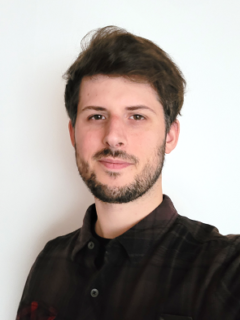Lukas Dahlem
Lukas Dahlem
Master student
Production of hydrophilised, melt electrowritten fibres to fabricate biphasic constructs in combination with hydrogels
Supervisors: Sonja Kuth, Prof. Aldo R. Boccaccini
Hydrogels can be used to form tissue-like structures by mimicking the extra cellular matrix (ECM) through a polymer network. Besides their tuneable mechanical properties, they are non-toxic, biodegradable, highly functionalizable by the incorporation of signal molecules and they are also 3D printable with various bioprinting techniques [1,2]. By combining hydrogels with structures made of biocompatible thermoplastic polymers it is possible to improve the mechanical properties of the bioprinted construct above the possible properties of hydrogels [3]. While bioprinted meshes, made from thermoplastics, already reinforce a tissue construct, melt electrowriting (MEW) provides an increased homogeneity in organisation while the cell mobility within the incorporated hydrogel is also increased [4]. By combining bioprinting of hydrogels and MEW of thermoplastics it is possible to fabricate an advanced biphasic construct with increased stiffness and stability [5]. The aim of this thesis is to improve the incorporation of melt electrowritten fibres into a 3D printed hydrogel construct by altering the hydrophobicity of the thermoplastic polymer to influence the wettability of the mesh like reinforcement structure and ensure a stable bond between the two phases.
[1] C. Vyas, H. Mishbak, G. Cooper, C. Peach, R.F. Pereira, P. Bartolo, Biological perspectives and current biofabrication strategies in osteochondral tissue engineering, Biomanufacturing Reviews. 5 (2020). https://doi.org/10.1007/s40898-020-00008-y.
[2] F.L.C. Morgan, L. Moroni, M.B. Baker, Dynamic Bioinks to Advance Bioprinting, Adv Healthc Mater. 9 (2020). https://doi.org/10.1002/adhm.201901798.
[3] T. Zehnder, T. Freund, M. Demir, R. Detsch, A.R. Boccaccini, Fabrication of Cell-Loaded Two-Phase 3D Constructs for Tissue Engineering, Materials 2016, Vol. 9, Page 887. 9 (2016) 887. https://doi.org/10.3390/MA9110887.
[4] D. Janzen, E. Bakirci, J. Faber, M. Andrade Mier, J. Hauptstein, A. Pal, L. Forster, J. Hazur, A.R. Boccaccini, R. Detsch, J. Teßmar, S. Budday, T. Blunk, P.D. Dalton, C. Villmann, Reinforced Hyaluronic Acid-Based Matrices Promote 3D Neuronal Network Formation, Adv Healthc Mater. 11 (2022) 2201826. https://doi.org/10.1002/ADHM.202201826.
[5] J.M. Visser Ferry P.W.; Jeon June E.; van Bussel Erik M; Kimpton L. S.; Byrne Helen M.; Dhert Wouter J.A.; Dalton Paul D.; Hutmacher Dietmar W.; Malda Jos, Reinforcement of hydrogels using three-dimensionally printed microfibres, Nat Commun. 6 (2015) 6933. https://doi.org/10.1038/ncomms7933.

